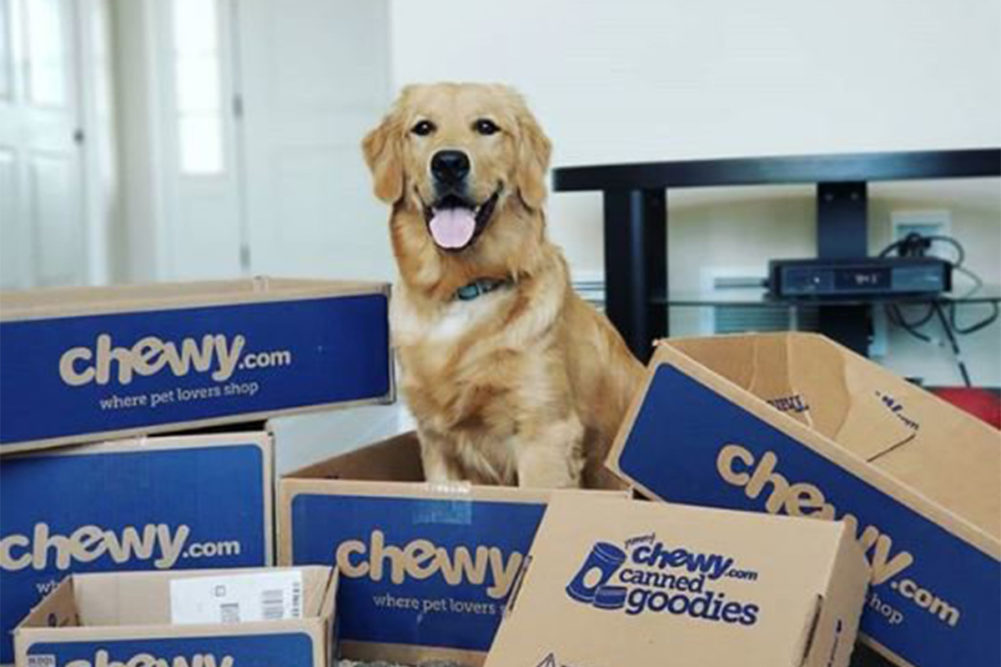DANIA BEACH, FLA. — Chewy, Inc. released its full-year fiscal 2020 earnings March 30, which testified to the pet product industry’s accelerated shift toward e-commerce over the year. The company reported a net loss of $92.5 million, including $129.2 million in share-based compensation expenses, and net sales of $7.15 billion, up 47% from 2019.
The company increased its customer base by 42.7% year-over-year, adding 5.7 million active customers, and increased “initial wallet share” by 12% among new customers compared to 2019, referring to the dollar amount of purchases made by new customers.
“The customer cohorts we acquired in 2020 were highly engaged and displayed similar and in some cases, stronger purchase and repurchase behavior compared to legacy cohorts,” said Sumit Singh, chief executive officer of Chewy. “These positive behaviors were driven by a wider product assortment and by a growing set of customer offerings, such as gift cards, personalized products, compounding services and Connect with a Vet.”
Additionally, first-year profits per customer are up 16% over the last two years, Singh pointed out.
The company’s full-year gross margin grew 25.5% in 2020, up 190 basis points from 2019 and representing a record-high for the company’s historical full-year gross margins. Chewy also achieved its first full year of positive adjusted EBIDTA growth, totaling $85.2 million in 2020.
“We generated $150 million more in adjusted EBITDA in 2020 than we did in 2019, demonstrating our ability to successfully scale the business and drive incremental profitability,” Singh said.
Mario Marte, chief financial officer, added Chewy’s operating expenses were $1.91 billion, or 26.7% of net sales, up 210 basis points compared to 2019.
“On a full year basis, our 2020 net loss improved $92.5 million from $252.4 million in the prior year, and our net margin improved 390 basis points to negative 1.3%,” Marte added.
The growing pet population in the United States due to the COVID-19 pandemic is one reason why Singh believes the company is “well-prepared to capitalize” on key industry trends.
“In 2020, we observed a 35% year-over-year increase in the creation of pet profiles for puppies and kittens, and a 40% increase in the creation of profiles for newly adopted pets,” he reported. “…Understanding our customers and anticipating their wants and needs help us create sustainable advantages to win in the pet space.”
Another opportunity for Chewy is continued premiumization of this market and increased pet spending. The now $100 billion industry poses many opportunities for the e-commerce pet brand.
“Today, we compete in roughly 70% of the $100 billion US pet market, and we do so primarily in the areas of food supplies and prescription drugs and diet,” Singh said. “That leaves us with an additional $30 billion opportunity in healthcare and services to grow into, and we are confident in our vision and our ability to do so.”
Singh also noted he believes the accelerated shift to e-commerce in the pet industry and in the United States in general will continue beyond the COVID-19 era, with 2020 and pandemic impacts serving “as much more than a one-time growth accelerator.”
To stimulate continued growth, Chewy will focus on a few areas of investment: acquiring new customers, increasing dollar spend of its existing customers, expanding its product assortment, growing its owned-brands and health care services, launching new services, and expanding internationally – “when the time is right,” Singh said.
Chewy has nearly doubled its total SKU count over the last three years, and will continue expanding its offerings to drive top- and bottom-line growth.
In October, Chewy opened its first fully-automated fulfillment center, from which Chewy hopes to “realize accelerated productivity gains” to a fuller extent in 2021, Singh said.
“We also expect to open our second automated fulfillment center in Q2 2021 in Kansas City, and another limited catalog facility in Q3 2021,” he added. “Additionally, in 2022, we will begin automation retrofits at select fulfillment centers.”
Looking to 2021, Chewy expects first quarter net sales between $2.11 billion and $2.13 billion, representing 36% to 37% growth over its prior first quarter revenue. This expectation has been adjusted for the “pantry-stocking” benefit seen across the industry in the first quarter of 2020.
Additionally, Chewy is projecting full-year 2021 sales between $8.85 billion and $8.95 billion, which would be a 25% to 26% growth from 2020 earnings.
“In 2020, we benefited from many tailwinds, some of which we expect to continue into 2021 and some of which may not,” Marte said.
Chewy acknowledged its completed split from PetSmart, a fact which will cause the company to bring some administrative functions in-house that were previously run through PetSmart.
“Even with this change, the operational and financial impact of the separation is de minimis,” Marte said.
Mate also mentioned an “industry-wide disruption in the availability and supply of wet canned food,” and noted while the disruption has not materially impacted Chewy, the company will remain vigilant on the issue.
“2020 was an incredibly challenging and unpredictable year for all of us,” Singh stated. “During this time, Chewy performed exceptionally well and made significant strategic and operational progress… Years of preparation and focus have positioned us as the internet’s preeminent neighborhood pet store and a leading pure-play e-commerce company in the pet space. We look forward to a future marked by ongoing innovation and to winning customers’ hearts and minds as we grow to become the most trusted and convenient online destination for pet parents (and partners) everywhere.”
Read more about corporate strategy, financial performance, mergers and acquisitions on our Business page.



